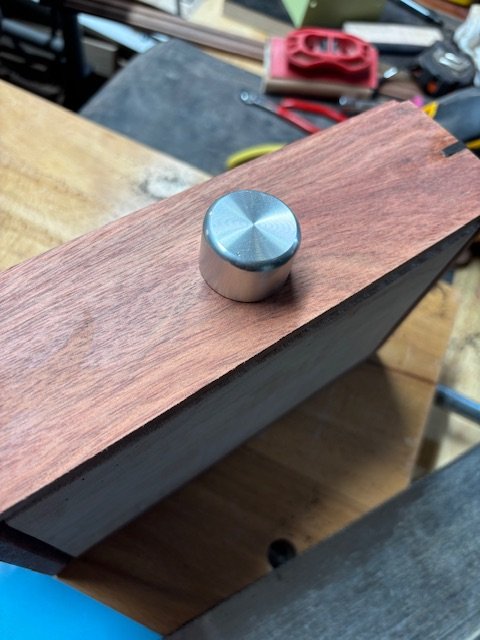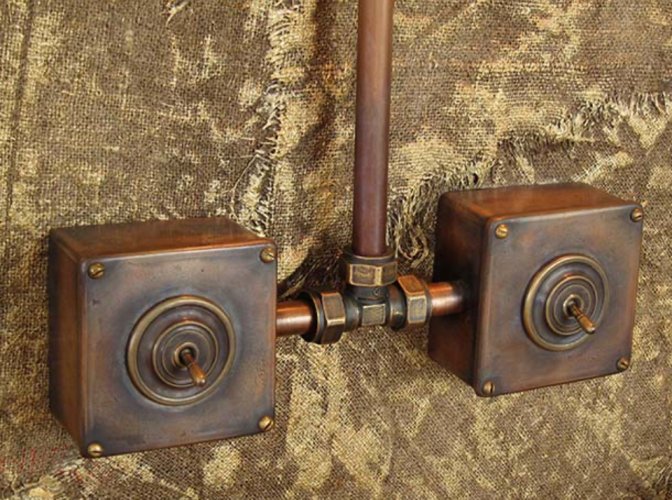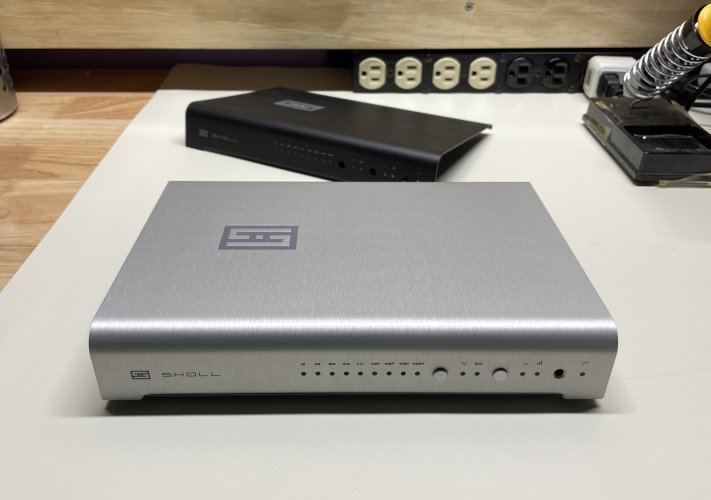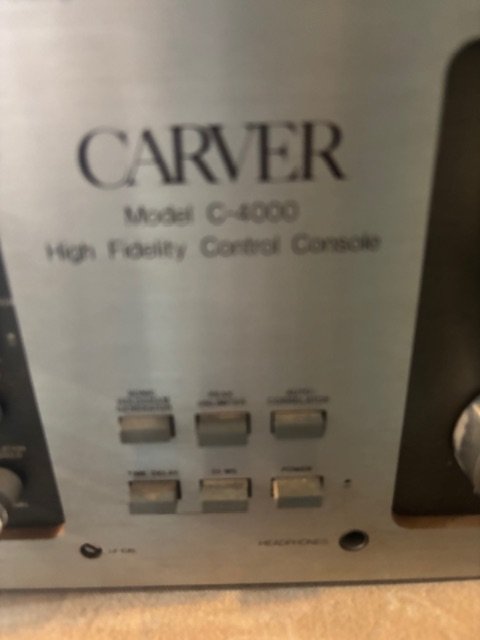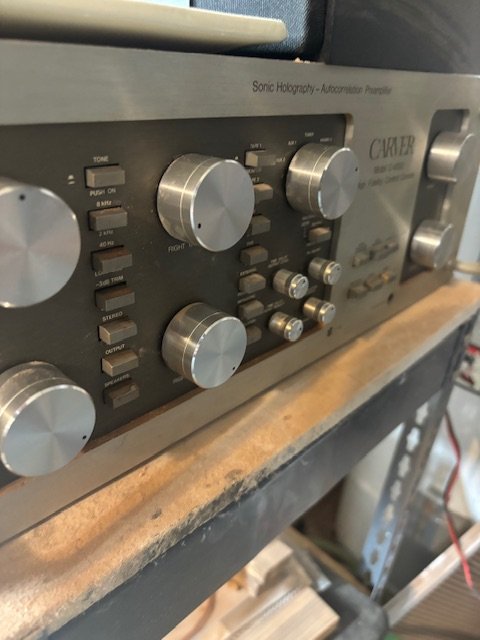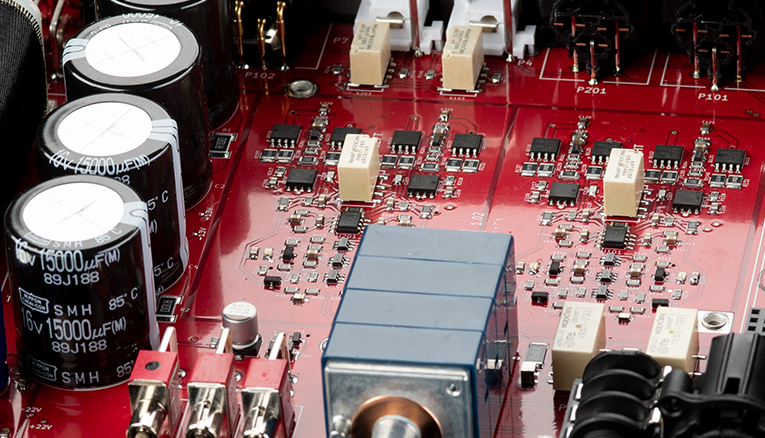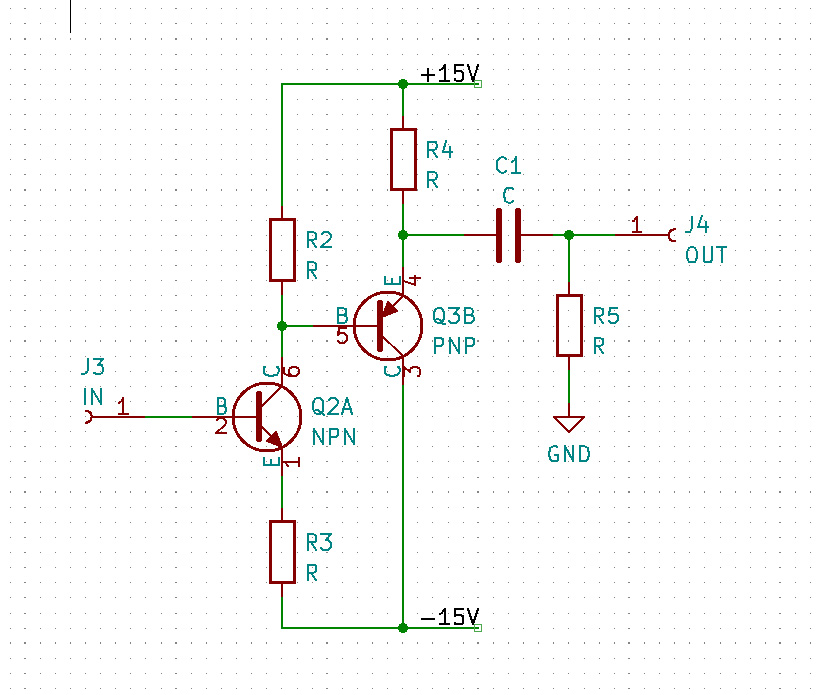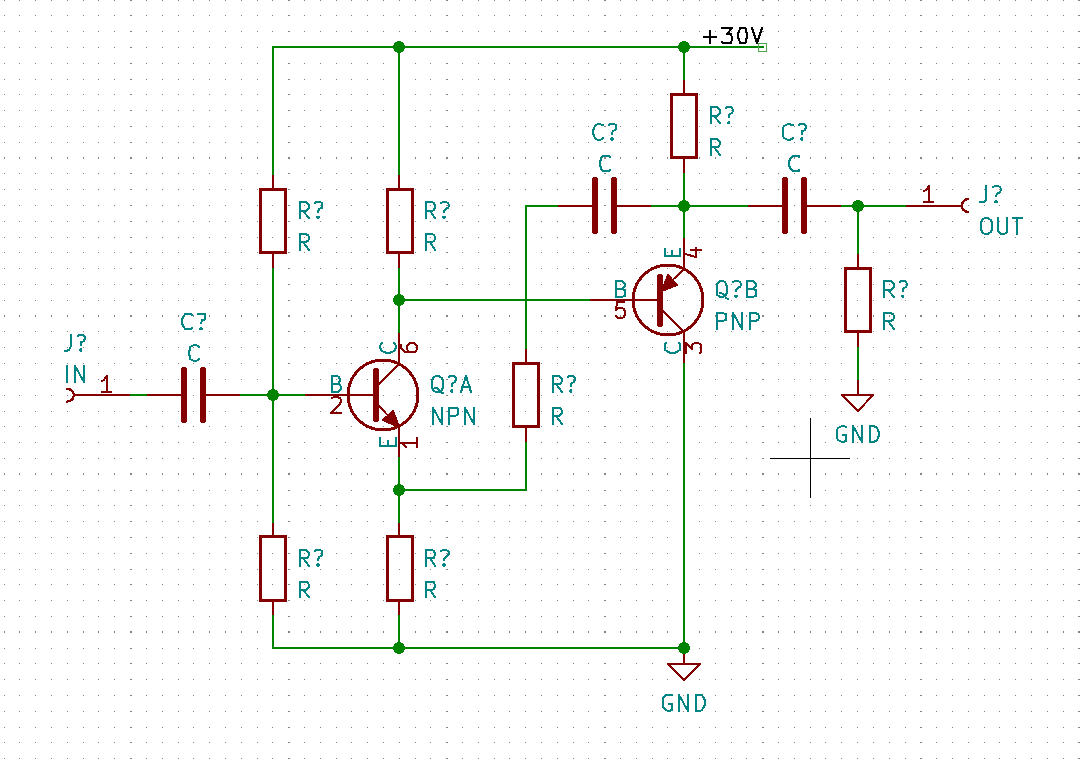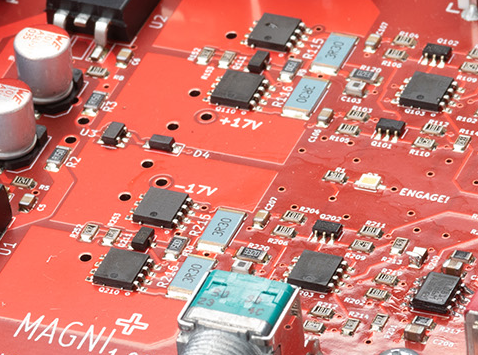2023, Chapter 7
The Most Abused Audio Terms, Part 3: Discrete
The last two entries in our “Most Abused Audio Terms” came with feel-good connotations: “Class A” and “Balanced” both sound really good. Nobody wants less than an A, and nobody wants to be unbalanced.
But “discrete?”
Hmm. Here’s a challenge:
define “discrete.”
I mean, do you mean “discrete,” as in the dictionary definition of
“having an independent existence or form apart from other similar things; separate:?” Because that’s kinda ambiguous in electronics terms, isn’t it?
Well, yes it is, and that’s why some idiot marketers like to abuse it. I mean, I’ve seen products clearly based on op-amps, or hell, even codecs, called “discrete.” So yeah, maybe those op-amps or codecs have an independent existence, but it ain’t discrete. No way, no how.
"Discrete" is further confounded by the fact that, in engineering, discrete-time systems are digital and continuous-time systems are analog. There's also the whole soundalike problem between "discrete" and "discreet."
Argh.
So let’s start by defining “discrete,” in terms of audio electronics:
Discrete: a circuit relying primarily on individual foundational active and passive components, including transistors, diodes, resistors, capacitors, and inductors. Not consisting primarily of integrated circuits or other complex, high-density electronic components.
And, while we’re at it, let’s define the counterpart, on the same terms:
Integrated: a circuit relying primarily on complex, high-density active devices such as op-amps, DACs, codecs, line receivers, instrumentation amplifiers, etc. Not consisting primarily of foundational active or passive components such as transistors, capacitors, etc.
Are we all good with these definitions?
“Well, what’s this ‘primarily’ bit?” someone might ask. “Seems weasel-wordy.”
Yeah, because a Discrete design may include an op-amp or two for housekeeping, like a DC servo or something, but you’re talking a couple parts out of hundreds. Similarly, an Integrated design is gonna use individual resistors and capacitors to get it going, but a handful of individual parts interspersed with ICs that have hundreds, thousands, millions, or billions (not kidding) of transistors is, well, yeah, not really discrete, is it? Hence “primarily.”
And, of course, it is possible that something is
Mixed, as in, say, a DAC with a discrete current-to-voltage conversion stage, or an amp with an op-amp front end and discrete output stage. It can also refer to a mixed-signal IC that operates in both the analog and digital realm. More on that shortly.
“I still don’t get it,” someone says.
Cool. So let’s start with some examples.
Integrated vs Discrete: Examples
Let’s start extreme. Here’s an example of a literal one-chip design that includes USB receiver, microprocessor, DAC, headphone amplifier, ADC, microphone bias, headphone jack sensing and active reconfiguration, RGB LED driver, and its own internal bipolar charge-pump power supply so everything comes out nicely at 0V, so there’s no coupling caps.
Stop. Go back and look at the schematic again. That one yellow blob in the middle, the CM6646, is a:
- USB receiver
- Microprocessor
- DAC
- Headphone amplifier
- ADC
- Microphone preamp
- Microphone bias
- Headphone jack sensing and active reconfiguration
- RGB LED driver
- Bipolar charge-pump power supply
Ten functions, both analog and digital. That’s
literally millions of transistors. In a
single package about ¼” on a side.
So what else is on the board? A handful of capacitors and resistors, a USB jack, an ESD protection diode array, and a headphone jack. That’s it. Plug it into a USB port, and you have a fully functional dongle DAC.
That is suuuuuuperrrr
Integrated.
So why don’t we do everything this way? Two reasons:
- Every function is compromised.
- It’d be hella boring.
Compromised? Yes. Take a look at the specs of the CM6646. It’s not going to win awards for DAC performance, ADC performance, headphone power output, or USB interface speed and capability. And that’s fine. It’s an inexpensive part. You could spend tens to hundreds of times as much as that chip on one of its many functions alone.
Boring? Yeah. Every designer gets to sit around and wait for the latest super-integrated part to stick in their same-o-same-o lookalike product, differentiated only by marketing pukes. Yeeeeeccchhh.
As I said, though, this is an extreme example. There’s no reason an Integrated design needs to be as uber-integrated as this codec. Many integrated designs will use a variety of ICs to achieve their goals.
A more typical example might be something like this, a balanced headphone amp composed of a differential op-amp and paralleled followers to increase its current output. Each of the shaded triangles represents an op-amp with hundreds (or more) transistors, resistors, and capacitors on a single chip.
Important disclaimer: this is not a real product, please don’t try to build it. It may have errors, may not work, or, if it works, it may not work properly, and, in any case, it doesn’t have any of the typical protection you need for a commercial product wrapped around it. It’s also not very exciting in any case.
Again. Stop. Go back. Read the above disclaimer.
Okay, now you can proceed.
Unlike the codec example above, this isn’t a complete circuit. To make it work, you’ll need a power supply (something that provides +/-15V would be fine), plus the jacks and connectors, plus volume control, plus protection in case of faults.
But since we’ve divided the functions into two:
- Differential voltage gain
- Current buffer
We have a lot more options. For example:
- If we didn’t need a lot of current, we wouldn’t need the paralleled parts to increase current output, and that would simplify everything considerably
- If we didn’t need as much current, we could use less paralleled parts
- If we didn’t want to go balanced differential, we could do this as a single-ended design using different ICs
- If we wanted to get fancy, we could do nested feedback or error correction
“Well, that seems like plenty of options to differentiate a design,” someone says. “Especially considering you also have to pick a volume control, do the power supply, and more.”
Oh ho ho.
Yeah there are a few options. But you are generally stuck with the design and capabilities of the ICs you chose for your integrated design. You’re not going to change the loop gain or alter the output stage to source inherently more current or swap everything over to current feedback if you started with voltage feedback or vice-versa. Nor are you going to be able to dramatically alter the ICs basic performance, except in horrible ways, like with a terrible layout that makes it perform far worse than its potential.
Bottom line, going Integrated means you’re more constrained. But that’s not always bad. It’s certainly safer. Doing an Integrated design means you have a higher chance of creating a product that works as expected. As long as you can understand the datasheet, and don’t run the parts outside their design envelope, you’re on your way to music.
But…to me anyway, it’s still life inside the box. Not super exciting.
Ready for the full crazy?
Cool, let’s talk discrete. Starting with this super-simple circuit:
One transistor. One resistor. Input. Output. Done.
Easy, right?
Sure. Except no competent engineer would ever propose this for an audio power amplifier. Even if you chose the right transistor and the right resistor, and the +/-15V came magically out of the air, you have the problem of the 0.6V or so of offset at the output, which will fry headphones pretty darn quick and speakers won’t be happy about and you’re not going to get much power out of this anyway because its stuck in Class A and super inefficient and by the way there’s no voltage gain either.
Let’s review:
- 0.6V (600mV) DC offset fries headphones and slowly cooks speakers
- No voltage gain
- Can swing less than half its rail voltage
- Super inefficient
“Wait, why is this so complicated?” someone asks. “How come one chip can have a million transistors and a bunch of functions, but one transistor doesn’t even work right?”
Simple: because that single transistor there demands the designer understand its electronic and physical properties, like:
- 0.6V or so voltage drop from base to emitter to turn the transistor on. So if you’re coming in at 0V, the output here is at -0.6V.
- Current will be set by voltage across emitter resistor, so in this case 14.4V/R. Better not choose R = 0.1 ohm or something, right?
- Transistors come in all shapes and sizes, with capabilities ranging from a few mA of current to tens of amps. However, when you’re talking big parts, you need to be aware of heat dissipation (heatsinking needs), safe operating area, thermal derating, and beta droop, or you can get in real trouble real fast.
- Oh yeah and this is only a BJT example. Not MOSFET. Not JFET. Not depletion MOSFET. Not tube. Not SICFET. There are a lot of examples, and they all have different characteristics.
- Oh yeah and BJTs are really current input devices…not voltage. So there’s special care and feeding there.
So yeah, even this “simplest” circuit has tons of nuance.
“Oh hell let me just do Integrated,” someone says.
And that’s totally fine. Most do. It’s wayyyyyyyy easier.
But not us. Let’s go a bit farther.
We can add voltage gain with another transistor and a couple of resistors, and take care of the output offset with a coupling capacitor:
This is better. We can now pick our voltage gain (roughly) as the ratio of collector to emitter resistance on the first transistor. This is useful when you’re trying to get a line-level signal (+/- 2.8V) to the +/-15V rails of this example. Except, oops, yeah, you can still swing less than half the rail voltage, so you’re really looking at +/-7V or so at most. And yeah, you now have a capacitor to block DC from the output, but now you have a big honking electrolytic in the signal path, which really needs to be biiiiiiiiig if you’re running 8 ohm or 4 ohm speakers, so that’s not so great either.
Let’s review:
- DC offset at output blocked with capacitor
- Voltage gain can be adjusted by changing collector/emitter resistance ratio
- Still can swing less than half its rail voltage
- Still super inefficient
So yeah, this is better, but it can’t get anywhere near its rails. And considering that swinging 30V into 8 ohms is 14W and swinging 14V into 8 ohms is 3W, that’s a biiiiig deal. So you might want to go with asymmetric rails, or do a single rail and bias the input at a logical midpoint, in order to increase efficiency. That will still be problematic, because if you’re using resistor biasing at the input, that’ll reduce input impedance and can cause more PSRR issues. Not that the PSRR, or Power Supply Rejection Ratio, is fantastic on this design, but amplifying any ripple on the input will make it worse. Aaaand even if you do that, it’s still going be an, ahem, interesting challenge, because 15V into 8 ohms is 1.875A—almost 2 amps!—of standing current, and that’s also 60W—that’s 60 watts!—dissipated in heat. 60 watts on one transistor is really, really a lot. I wouldn’t try it, personally.
Oh yeah, and this will measure like ass. Low loop gain and single transistors run all the way to the edge of their envelope will do that.
But if you really wanted, you can add feedback to this example, to improve measured performance (though it will still measure poorly.)
Now you have a “complete” amplifier. It even addresses the output voltage swing issue with input biasing. But it is still very, very bad.
So more review:
- Need to use a DC blocking cap if biasing at the input
- May have additional PSRR issues (noise) if biasing at the input
- Still gonna run a ton of current at idle, and dissipate a ton of heat
- Will need a big heatsink
- May be too much for a single power transistor
- Oh yeah and will measure like ass, even with feedback.
“Holy moly, that’s a lot to consider!” you say. “How do you ever get a working design with limitations like that?”
Two ways:
- Be smart in the use of your transistors, like the famous JLH Class A amp from the late 1960s. This adds another transistor and a few more parts and gets reasonably good performance.
- Use a modern topology, formulated in an era when transistors got less expensive. We’re talking complementary output, Class AB, Lin or Blameless designs, or our fully complementary current feedback designs, or Nexus, or supersymmetry. These designs are (ahem) a bit more complex.
How complex is a modern topology? Let’s look at a typical voltage feedback example:
And yes, I know, now your head exploded. How the heck do you get from two transistors to this? Because why so many parts? Why so much weird stuff? What the heck are all those transistors doing?
Well, if you want to take a deep dive into this, I can heartily recommend
Bob Cordell’s Designing Audio Power Amplifiers book. It starts with a basic topology that is a bit simpler than this, explains how it works, and then starts building on it in ways that increase its performance. If you ever wanted to know how you optimize a modern discrete design, and especially if you wanted to know the difference between BJT and MOSFET designs, doubles and triples, voltage and current feedback, feedforward, feedback, and no-feedback strategies, that’s your book.
But, in the meantime, let me break it down a bit. This circuit has so many transistors because it’s designed specifically to address all of the limitations of the simple circuits we’ve been playing with. Let’s go through some of it:
- Differential input stage with current source, degeneration, and active loads. The input stage of this amp is differential for many reasons, but mostly because it provides for higher PSRR and gives you a perfect terminal to return feedback to. This diff amp uses a current source to increase CMRR (Common Mode Rejection Ratio) and improve performance. It also uses active loads and degeneration to increase gain and linearity.
- Buffered interstage. We could connect the input stage directly to the second voltage gain stage, but buffering the output of that stage increases performance and loop gain.
- Single-ended VAS with current source. The bulk of the voltage gain of this amp happens here. In this case, we’re using a single-ended VAS with a current source load, similar to the front end. But probably different transistors. Choosing transistors for input and VAS can be very different things. Get Cordell’s book for more info.
- Vbe multiplier bias. We’re going Class AB here, so we want good control of the output bias. A Vbe multiplier allows us to adjust this to whatever we need—though this is a very simple Vbe multiplier—there are ones that are much more stable with varying current and temperature, and we’d probably go that way in a real design.
- Driver stage. From the VAS, we have a driver stage that provides current gain to drive the output transistors. This is important, because it keeps the loading on the VAS more constant and improves performance. Again, this is a pretty simple implementation.
- Paralleled Class AB output stage. Remember that “beta droop” I mentioned? Paralleling output BJTs helps ensure you never get to that point. Or you could use MOSFETs, but be careful of their input capacitance and be careful not to exceed their Vgs ratings.
- DC servo (hey, op-amp!). And yeah, there we go—there’s an IC in here! This is a DC servo that keeps the output at 0V. Notice there’s no coupling caps here—it’s DC in, DC out. There are other ways to manage DC, including trimpots, microprocessor oversight, etc…but this is a simple way that works well. And we could have a whole discussion on the DC servo…how many poles, where it’s connected, what kind of caps…but I’ll spare you that.
- Stacked rails. Sharp-eyed readers noticed that this topology runs on two different sets of rails: +/-18V and +/-24V. Why do this? Because it allows us to run the output stage all the way up to the rails, without any crazy stuff like bootstrapping. A neat little trick if you have the transformer windings to do it.
Now, let me stress: this is super-basic stuff. Super duper basic. You can easily add a predriver stage for an output triple, you can do Hawksford/Cordell error correction, you could lose the diff input and go current feedback, you could go full differential all the way thru with Supersymmetry or Nexus topologies, you could go to nested feedback or no overall loop or non-active loads or…or…or…you get the idea.
Oh yeah and same disclaimer applies here as in the first examples: this is not a working amp, this is not even something we make. It’s just an example. Have fun calculating the right values for it (and don’t forget the compensation), but don’t be surprised if it doesn’t work at all due to some bonehead mistake on our part.
Oh yeah, and, just to be clear: this is still just a single amp stage with no power supply, no input switching, no I/O, no protection…it’s not a viable product.
“So what does a viable discrete product look like?” someone asks.
Well, it depends. You could add a simple wall-wart supply with fixed regulators, a couple jacks and pots, and a relay delay, and get this working. Or you could put 4 of them together like this into a fully balanced (but not differential) amp with internal dual mono power supplies, stacked rails, and a “bridging” option, and it would look like this:
“Ahhh, make it stop!” someone cries. “How many parts is that?”
Actually not that many. Only about 400. That’s not terrible. We’ve played with discrete designs with over 1000 parts, and that includes microprocessor oversight.
Why Hit Yourself with a Hammer?
Now, some of you are scratching your heads and wondering, “Why bother with all this discrete stuff when you can get chips that are, essentially, your “modern discrete” on steroids, and other chips that do wayyyyyyy more than that? Why hit yourself with a hammer when you can relax on a feather bed?”
To understand why some people, like me, appear to be clinically insane, let’s take a look at the strengths and weaknesses of both kinds of designs.
Integrated Strengths
- Generally easier to implement. For all the yelling, here it is: Integrated designs are easier. It’s far easier to drop in an op-amp with hundreds or thousands of components than putting hundreds or thousands of discrete components on the PC board. As added bonuses, compensation is also usually worked out, and power supply rejection is better, further easing design.
- Generally simpler, less parts. Thousands to billions of transistors and supporting components on a chip mean less parts on the board. This can translate to faster assembly, lower cost, and higher reliability.
- Can have many complex functions on one chip. Why stop at op-amps. Look at the CODEC example above. Or any number of super-complex electronic things you’d like to do. Integrated vastly simplifies your design. And, in many cases, it may be the only way you can do it. Imagine doing a USB receiver, microprocessor, ADC and DAC in discrete. Bring a warehouse as a chassis for it.
- Usually less risky, more straightforward to get right. ICs are usually fairly well defined; you know what’s going to overstress them, and they usually have at least some kind of protection built in. This means you’re less likely to end up in one of the analog hells, dealing with oscillation, noise, or other gnarly problems that can waste a lot of time.
- Usually better measurements. If you’re talking op-amps and line-level stuff, ICs are usually the best way to help ensure state-of-the-art measurements. Some perform at insanely great levels, at or near the best you can achieve.
- Can be faster to market. Because you are doing an easier, simpler, less risky design, it can be faster to get to market when going integrated. There’s just less to get wrong, and less gotchas to get you sidetracked.
- May be less expensive. When comparing total cost, including assembly cost, integrated designs may end up being less expensive, even if the ICs cost more than individual discrete components.
Integrated Weaknesses
- What ya got, ya got. Want a USB receiver with an ADC and mic input, but don’t want all the other CODEC stuff? Nah, sorry about that. Want an op-amp with the performance of an OPA1656 but runs at +/-30V? Nopers. Like a multiplying DAC with 20 bits and current output? That’s a notgonnahappen.com. ICs do what they do, no more and no less, and they have the specs they have, no more and no less. So your “simple” design that might be just fine with a single CODEC suddenly became wayyyyy more complicated because you wanted better THD+N performance, and your 1 chip, 20 part design turned into half a dozen chips and 100 parts.
- Sit n wait with everyone else. Want better performance than the ICs currently on the shelf? Well, get in line, bub, and wait for the tiny handful of IC companies to update their line. And then fight for stock. And then start waiting again for the day something new and better comes out. Wash, rinse, repeat. Kinda boring, right?
- May have hidden gotchas. Oh yeah that part is totally fine—well, unless you use both channels to the max, or if you surpass its ESD rating in a way it doesn’t particularly like, or if it has a tendency to latch that isn’t in the datasheet, or if the manufacturer-supplied info is kinda cryptic about how to get the best performance out of it. Sound far-fetched? Oh no, we’ve personally encountered each and every one of these. Read the datasheet. Carefully.
- Not great at high voltages. Most op-amps go boom if you try to run them at over 36V. The ones that go higher are super-rare, poor performers, very expensive, or all of the above. If you’re working in the realm of power amps, that voltage limitation will be a problem. As will current limits.
- Not a lot of topological choices. If you’re talking op-amps, most of them are standard single-ended, voltage-input, Lin/Blameless style devices. Want to do current feedback? Want to have access to the internals so you can change loop gain or compensation? Your options just got very, very small.
- Heat dissipation can be a problem. All devices are limited by their package, and there aren’t many ICs that are designed to dissipate a ton of heat, like a TO3-P transistor. Yeah, there are a few “audio amps” out there, but they still aren’t an option if your’re designing, say, in the 200W realm.
- Not necessarily the highest performance. Surprised? Yes. Because inherently, ICs need to be fairly stable and easy to use. This means you can’t do all the crazy edgy tricks to get absolute maximum performance, as with a discrete design. Want to do a massively paralleled input stage to bring down noise for a high-gain application? Nah. Want to go transimpedance? Good luck. Your choices are slim…or none.
- May be more expensive. Some ICs are also very expensive—surprisingly so. In fact, some can actually cost more than an equivalent discrete circuit. It pays to run all the numbers, and never assume that Integrated is always cheaper.
Discrete Strengths
- Complete freedom in design. Want to do a massively paralleled differential transimpedance phono preamp? Sure. Want to make an amp with 180 15A output devices for 1000W into 8 ohms? Sure. Want to make an I/V stage for a DAC with 100x better settling than any op-amp that can take +/-20V rails? Sure. Want to go low loop gain and current feedback? Absolutely. Differential? Sure. Class A? Sure. Class S? Go for it. Want to use new-tech devices like GaNFETs and SiCFETs? Go ahead. Want to mix tubes and transistors? Anytime. Want to come up with something new like Supersymmetry (which TI bought) or Nexus? Also just peachy. Go wild.
- Can shoot for any performance level. Whether you’re doing a 0.5% THD tube design or a -120dB THD+N differential discrete design, it’s your choice. You can also easily design for exceptional open-loop linearity, measure your design open-loop, compensate it precisely, and incorporate compensation schemes that increase performance—and use the best resistors, capacitors, and inductors for the job, rather than being limited by what can be put on a chip.
- Any topology, including new ones. As mentioned before, Nelson Pass’ Supersymmetry was patented and then purchased by TI. If you’re using their differential op-amps, you may be using this exact topology. The performance—and sound—are good. If we’d all sat around waiting for a better “797,” this would never have happened.
- Less scary when supply chains are constrained. When OPA1612s are unobtanium, they’re gone. Bye-bye. Sorry about that. Start the cage matches. Not so with discrete devices, which (a) usually stay in stock, and (b) usually have alternates, and (c) if you’re designing discrete and really in a pinch, you can design around it, rather than waiting for the supply chains to improve.
- The choice for high voltage. Looking to do speaker power amps? Electrostatic amps? Anything over +/-20V or so is really the province of discrete. Yeah, maybe there are a handful of high-voltage op-amps, but you’re still very limited. There’s nothing you’re gonna bolt to a heatsink and get a 200W RMS x 2 amp out of. Period.
- The choice for high current. Same as voltage. Once you’re past 100mA (give or take), you’re looking at discrete for answers. Sure yeah there are a few low-voltage or high-cost devices that do more, but with discrete devices rated to dissipate 150W and designed for heatsinking, or even board-mounted devices with thermal lands underneath and capable of running 175 degrees C continuous, the horizon is a lot farther out.
- Better with ESD. It’s hard to kill discretes with static. A lot harder than ICs. You won’t have to worry about that so much. Pay attention if you’re using MOSFETs, though…
- May be less expensive. Discrete devices, in general, are cheap. Even with assembly cost factored it, it might beat an expensive op-amp. It also, in the case of high voltage and power, be the only way to do it. Because in the same way you don’t want to see a discrete microprocessor, you don’t want to see 1000 op-amps paralleled to drive speakers. Or at least I don’t think you do.
Discrete Weaknesses
- Deep understanding required. As with integrated, when all the yelling is over, it comes down to this: discrete design requires deep understanding of the parts, how to use them, their strengths and weaknesses, their particular “care and feeding” oddities, as well as knowledge of stability, compensation, noise rejection, aaaaannnnd patience to work through all the quirks and oddities and half-working states. Not many people want to do this. Especially when there are easier options.
- Parts n parts n parts n parts. Discrete means a lot of parts. A small gain stage will be 25-40 parts; with power supply and protection in a stereo application, that’s 100-150 parts. Parts counts can balloon to the 400-600 part level easy. Four digits isn’t unusual. That means your assembly partners need to be very, very good, and your techs need to be ready for this level of complexity.
- Needs protection. Aaand…unlike ICs, which usually have some level of protection to help keep them from going boom, discrete inherenly has…none. So you’re going to want to learn how to protect your creations, monitoring current and temperature to make sure nothing goes awry. Hello more complexity.
- More things to go wrong. No matter how you slice it, more parts is more things to go wrong, more solder joints that can go bad, more stuff a PCB house can mess up. Sounds scary, but the reality is that with a good partner doing the boards, it becomes virtually a non-issue.
- Can be slower to market. Because there’s more complexity, and more gotchas (and, let’s be honest—more chance to play around with cool new ideas), this might slow down the development of a discrete product, which may mean you’re not first to market. For some things that matters. Others not so much.
- May be more expensive. With all those parts, your Discrete design may end up being more expensive than an equivalent Integrated design. Know what your assembly costs are, and factor them in. And be realistic about what you’re making.
“Now, aren’t you oversimplifying?” someone says. “I mean, isn’t there room for both approaches?”
Sure. Especially when you’re talking about complex devices. A DAC, even with a discrete output stage, is hardly a Discrete product. Same with our own Syn, which has a discrete gain stage for the main channels, but uses op-amps to derive the surround, center and sub…and also has a DAC, ADC, and other integrated functions. Those are
Mixed devices.
Simpler stuff is easier to break down:
Magni+: Discrete
Magni Heretic: Integrated
Asgard 3: Discrete
Magnius: Integrated
It's even more important to remember there's nothing inherently bad about either approach. The very well-regarded Bifrost 2 is an Integrated product by our definition—not a single solitary transistor in there! As are most versions of Yggdrasil—only OG has some discrete in its output stage. At the same time. Magni+ is discrete, performs insanely well, is made in the USA, and costs a shade over $100. It's OK to call a design Discrete or Integrated—neither is a slur. But it should be descriptive and accurate, right?
Which kinda brings us back around to where I started: some people calling stuff discrete…when it clearly isn’t.
How to Tell What’s Integrated and Discrete
Oh boy. I wish this was easier. It really comes down to looking at the board. And that’s a royal pain in the arse. It’s made even worse by the fact that there are devices that look a lot like 8-pin op-amps, but are actually just dual discrete matched transistors. We use a lot of them, and so some people have said, “Ha! Look at that! And they claimed, ‘discrete!’”
Yeah, we did, because it is discrete. Look closer at the image below. You’ll see 7 big packages that have 8 pins. 6 of them have pins on one side, and a waffle on the other for the thermal pad underneath. Those are the paired transistors. One, in the bottom right, is taller and only has pins. That's an IC (for the DC servo.)
You’ll also notice we use a lot of 6-pin devices in the image above, rather than the typical 3-pin transistors that you might expect. What are these? Dual matched transistors, again. Not op-amps.
So let’s start by how you tell on our products:
- We’ll tell you if it’s Discrete.
- We’ll tell you where discrete is used if it’s Mixed.
As in, we’re not going to take a product like Fulla (which has a couple of op-amps and a bunch of resistors and capacitors, in addition to the digital section) and say it’s “discrete,” though that does seem to pass muster with other companies. Maybe because the op-amps and resistors are separate? I don’t know. I don’t do their logic. I do our logic.
And that’s why you’ll find us saying things like:
“Syn has a discrete main gain stage and uses op-amps to derive the surround channels,” and “Magni+ is fully discrete.”
But you won’t hear us claiming Bifrost 2 or Yggdrasil LIM is discrete.
So let’s leave it at that.
We’ll tell you. Other gear? That exercise is left to the reader.
Why Discrete Matters
Let’s cut to the chase: it matters in the same way as “Class A” or “Balanced.” As in,
maybe not at all. If you like the way something sounds, why should it matter?
But for me, it’s more than that. Blame this on the fact that I’m an analog discrete designer, maybe the last of a dying breed. Blame it on the fact that I like nonstandard topologies (another op-amp, even discrete, is pretty boring to me). Go ahead. Make it personal. Make me the crazy person.
Because maybe I am. But I will continue to work on discrete designs, both for practical reasons (speaker amps) and more nebulous reasons, like wanting to craft something more than a workaday design, wanting to bring something more than “another great OPAXXX” design to the table.
And I really hope others continue as well, because, let’s face it, a world where everything is “the best measuring opamp of the day + the best measuring DAC of the day,” is a grim, gray, boring place indeed.
Let’s work out new things. Let’s have some fun!
Thanks again for reading.




